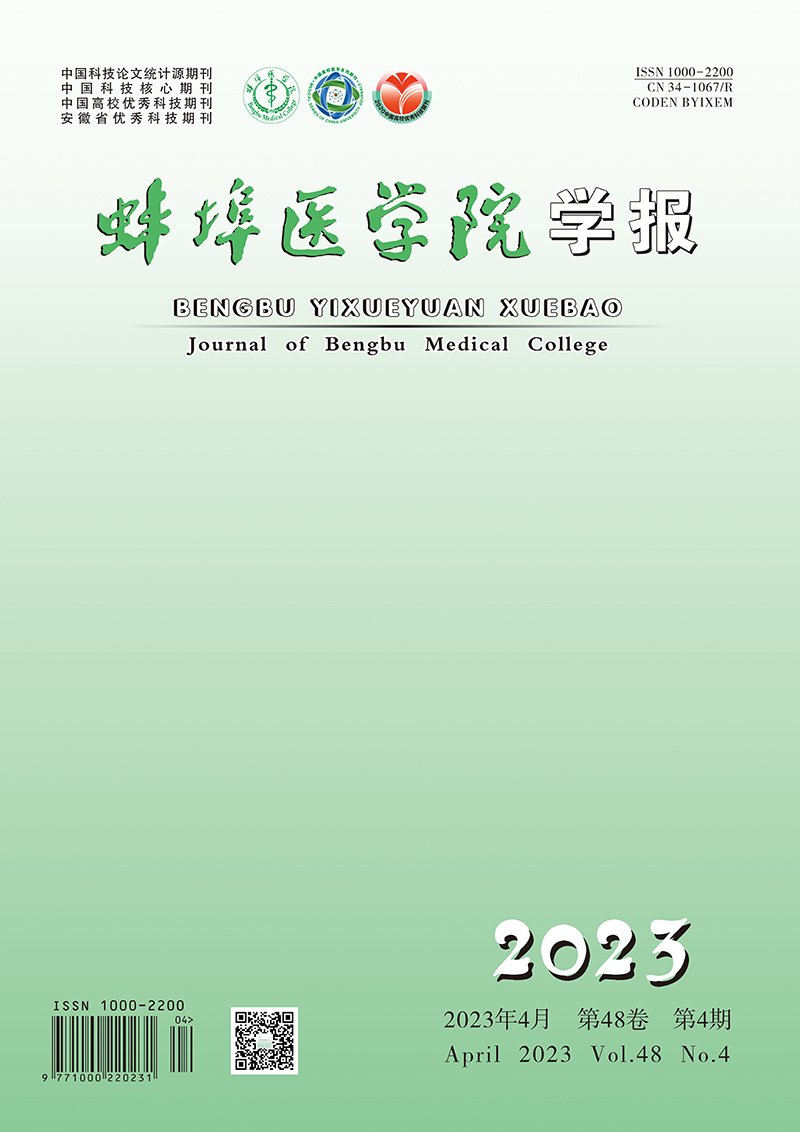-
原发性支气管肺癌多数起源于支气管黏膜或腺体, 是常见恶性肿瘤, 且男性患病高于女性, 其致死率较高, 是世界范围内急需解决的公共健康问题。美国每年有大约83万人死于肺癌[1], 约占所有患癌死亡人数的1/3。而我国每年大约有78.7万人被确诊为肺癌, 其发病率可达57.26/10万[2]。大部分肺癌病人确诊时已处于中晚期, 5年生存率为11%[3]。原发性支气管肺癌主要分为小细胞肺癌(SCLC)和非小细胞肺癌(NSCLC)两大类, 其中NSCLC约占85%。目前, 常用的肺癌实验室检测指标包括癌胚抗原(CEA)、神经元特异性烯醇化酶、鳞状上皮细胞癌抗原等。这些肿瘤标志物具有一定的灵敏性和准确性, 使得其在肺癌诊断、分型及预后评价中具有重要的提示意义。近年文献[4]报道, 全身炎症已被证明是恶性肿瘤发生和进展的重要表现。外周血中性粒细胞(NE)减少、血小板(PLT)增多和相关淋巴细胞(LY)减少, 有可能作为术前可获得的预后指标[5-7]。外周血中性粒细胞/淋巴细胞比值(NLR)、血小板与淋巴细胞比值(PLR)亦可能对肺癌的早期诊断具有一定的诊断价值[8-9]。本研究探讨肿瘤标志物联合炎性指标物应用于NSCLC诊断及早期诊断的最佳诊断模型。现作报道。
HTML
-
收集2017年1月至2018年6月西安交通大学第一附属医院确诊且未经治疗的NSCLC病人147例。其中男101例, 女46例; 年龄(62.7±9.3)岁; 腺癌92例, 鳞癌55例; Ⅰ+Ⅱ期47例, Ⅲ期+Ⅳ期89例, 未明确分期11例。NSCLC病人TNM分期参考国际抗癌联盟2009年制定的第7版国际TNM分期标准。收集同期健康体检者84名作为对照组, 其中男52名, 女32名, 年龄(58.0±10.4)岁。
-
采集初诊NSCLC病人和对照组外周静脉血, EDTA抗凝, 采用SYSMEX-XE2100型血细胞分析仪及原装配套试剂(稀释液、白细胞分类溶血素、鞘液、清洗液)[购自希森美康医用电子(上海)有限公司], 进行白细胞(WBC)、PLT、NE、LY测定, 并计算NLR、PLR。另取促凝管采静脉血3 mL, 充分离心后取血清保存于-20℃冰箱待检。血清CEA和细胞角蛋白19片段(CYFRA21-1)采用电化学发光法检测, 采用德国罗氏E170型全自动化学发光免疫分析仪及罗氏公司提供的配套试剂盒进行检测。
-
采用方差分析、χ2检验、t检验、秩和检验。
1.1. 一般资料
1.2. 方法
1.3. 统计学方法
-
NSCLC组病人WBC、PLT、NE、NLR、PLR、CEA、CYFRA21-1均明显高于对照组(P < 0.01), LY明显低于对照组(P < 0.01)(见表 1)。
分组 n WBC/(×109/L) PLT/(×109/L) NE/(×109/L) LY/(×109/L) NLR PLR CEA/(ng/mL) CYFRA21-1/(ng/mL) 对照组 147 5.95±1.67 210.5±63.5 3.61±1.34 1.83±0.48 2.04±0.81 120.5±44.84 1.68(1.20~2.17) 1.92(1.48~2.37) NSCLC组 84 7.16±2.67 235.4±77.9 4.92±2.40 1.60±0.60 4.01±4.89 176.0±122.00 3.62(2.00~6.96) 3.73(2.33~6.90) t - 4.24 2.64 5.33 3.19 4.78 4.97 1.35* 1.68* P - < 0.01 < 0.01 < 0.01 < 0.01 < 0.01 < 0.01 < 0.01 < 0.01 *示uc值 -
Ⅲ+Ⅳ期NSCLC病人WBC、NE、CYFRA21-1水平均高于Ⅰ+Ⅱ期(P < 0.05)。鳞癌病人CEA水平低于腺癌(P < 0.05), CYFRA21-1水平高于腺癌(P < 0.05)(见表 2)。
分组 n WBC(×109/L) PLT(×109/L) NE(×109/L) LY(×109/L) NLR PLR CEA/(ng/mL) CYFRA21-1/(ng/mL) Ⅰ+Ⅱ期 47 6.41±2.40 220±77.00 4.27±2.27 1.61±0.54 3.54±5.39 155.6±101.90 3.28(1.98~4.98) 2.96(1.84~4.21) Ⅲ+Ⅳ期 89 7.61±2.77 246±78.00 5.36±2.46 1.57±0.63 4.42±4.87 192.46±135.16 4.27(2.04~8.22) 4.66(2.76~11.02) t - 2.51 1.86 2.52 0.37 0.97 1.64 1.83△ 2.97△ P - < 0.05 >0.05 < 0.05 >0.05 >0.05 >0.05 >0.05 < 0.05 腺癌 92 6.94±2.80 226±65.55 4.74±2.54 1.59±0.56 3.98±5.62 165.68±105.42 4.35(2.02~8.92) 3.07(2.09~5.78) 鳞癌 55 7.61±2.39 251±93.81 5.30±2.14 1.62±0.65 4.09±3.41 195.00±145.39 3.14(1.99~5.28) 5.25(3.19~14.05) t - 1.48 1.90 1.37 0.30 0.13 1.41 1.33△ 0.27△ P - >0.05 >0.05 >0.05 >0.05 >0.05 >0.05 < 0.05 < 0.05 △示uc值 -
单项指标检测以CYFRA21-1敏感性最高, 而CEA特异性最高, 四项指标联合检测优于单项检测。本研究对CEA、CYFRA21-1、NLR和PLR四项联合检测早期诊断NSCLC价值进行分析, 结果显示其敏感性和特异性分别为83.0%和86.9%(见表 3)。
指标 AUC(95%CI) 敏感性/% 特异性/% 约登指数 CYFRA21-1 0.833 71.4 88.1 0.595 CEA 0.802 61.2 92.9 0.541 NLR 0.737 61.2 82.1 0.434 PLR 0.681 38.8 89.3 0.281 四项联合 0.926 83.7 95.2 0.741 四项联合早期诊断 0.881 83.0 86.9 0.699
2.1. 2组受试者各指标比较
2.2. 不同TNM临床分期和不同病理类型NSCLC病人各指标比较
2.3. CEA、CYFRA21-1、NLR和PLR单项及四项联合检测NSCLC价值比较
-
近年文献[4]报道, NLR升高已被认为是各种癌症预后不良的重要指标。中性粒细胞通过分泌细胞因子、趋化因子和生长因子等增殖因子, 也可能促进炎性微环境的形成, 促进肿瘤的生长、血管化和转移[10]。已有报道显示胰腺癌[11]、乳腺癌[12]、结直肠癌[13]、NSCLC[14]、食管癌[15]等恶性肿瘤中PLR和NLR可能具有独立的诊断、疗效及预后价值。外周血高水平的炎症性生物标志物往往预示着癌症病人预后不良。此外, 越来越多的证据表明炎症反应与肿瘤分期具有相关性[16-18]。XU等[19]研究表明, PLR和NLR可能分别是NSCLC病人T期和N期潜在的和独立的预测标志物。
PLR与NSCLC病理类型的相关性尚未见报道。潘颖等[20]研究发现PLR在鳞癌病人外周血中明显高于腺癌病人。但本研究结果显示PLR和NLR在鳞癌和腺癌中差异无统计学意义。后期我们将扩大样本量进行深入研究。但我们的结果显示CEA和CYFRA21-1在鳞癌和腺癌病人中差异有统计学意义, CEA在腺癌中表达水平较高, CYFRA21-1在鳞癌中表达水平较高; 而不同分期病人的WBC、NE和CYFRA21-1、NSCLC差异均有统计学意义, 晚期表达量明显高于早期。
本研究比较NSCLC病人和健康体检者外周血WBC、PLT、NE、NLR、PLR、CEA、CYFRA21-1水平, 并分析这些生物标志物在不同NSCLC分期及病理类型中的差异, 利用ROC曲线筛选NSCLC诊断及早期诊断的最佳的诊断模型, 为临床诊断提供理论依据。结果显示, NSCLC组病人血液指标WBC、PLT、NE、NLR、PLR、CEA、CYFRA21-1水平均明显高于对照组, LY水平明显低于对照组。ROC曲线分析发现, 单项检测时CYFRA21-1在取临界值2.69时, 诊断NSCLC的敏感性和特异性均较高分别达到了0.714和0.881, 约登指数为0.595;当采用联合检测时敏感性和特异性均得到了提高分别达到了83.7%和95.2%, 约登指数为0.741。提示联合检测对NSCLC病人的诊断具有重要的意义, 与UNAL等[21]研究结果一致。单一标志物的敏感性及特异性无法达到高度统一, 敏感性高者特异性较低, 而特异性高者敏感性又较低, 不利于肿瘤的诊断与鉴别诊断。而四项指标联合后能有效降低漏诊率, 且对早期NSCLC亦具有一定诊断价值, 因此, 此模型可用于肺癌的早期诊断, 尤其是对高危人群的筛查, 当筛查出阳性后, 还应结合临床症状、影像及病理方法作出最终判断。综上所述, 肿瘤标志物和炎性指标联合检测诊断NSCLC, 相对于单项指标检测, 可提高诊断的灵敏性、特异性及准确率等, 有重要的临床参考价值。






 DownLoad:
DownLoad: